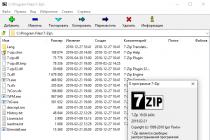Hello everybody. Recently, a friend of mine asked me to reinstall the operating system on his laptop, but unfortunately the OS did not load and it was impossible to determine which version of Windows was installed on the laptop. And it is very important to know this! For example, if Windows 10 Home for one language was installed on a computer device from a store, then it must be installed, only in this case the operating system is activated automatically immediately after the installation process. I asked a friend if he remembered the version of his system, but he shook his head and said that he was using the main browser.The laptop was not new and absolutely without stickers, nabout my data, even Windows 7 could be installed on it.
How to find out the Windows version if the system does not start
Friends if you need to know Windows version, but you cannot get into the system itself, then you need to boot the computer from Live CD. You can use my Live CD program created by me personally by Dmitry Malyshev with a selection of programs, or you can use a more powerful emergency Live CD from Sergei Strelets. But, let's talk about everything in more detail.
Live CD from Dmitry Malyshev
Downloading the Live CD in my cloud storage, then we create from it bootable USB drive, from which you can boot a simple computer with a regular BIOS, as well as the most new laptop with UEFI interface. Friends, if you do not know how to create such a bootable USB flash drive, then here is a very... T Now we boot from a USB flash drive our laptop with Windows, the version of which we need to install.We choose in boot menu laptop USB flash drive and boot from it.
Click "Ok".

The Live CD desktop appears.

Go to the "Soft" folder.

We go to the WinNTSetup3 folder.

Run the executable file WinNTSetup_x64.

The main window of the WinNTSetup3 program opens.

Right-click on the top of the program window.

And the following window opens, in which we see the version installed on our laptopWindows 10 Home Single Language (Windows 10 Home Single Language) are also visible license key systems.So in a simple way, using the program WinNTSetup3, we learned Windows version. But that is not all.

I am sure you will like one more way. We return to the "Soft" folder. Go to the ProduKey folder.

Launch the ProduKey program.

As you can see, ProduKey named the version incorrectly, but it doesn't matter, you just need to configure the program correctly.

Click File -> Select Source.

Check "Load the product keys from external Windows directory" and click "Browse".

In the explorer that opens, you must tell the program Windows folder with an installed operating system. We open the disk in the explorer window(C :) and select the Windows folder with the left mouse, then click OK.
It is important to know that all LiveCDs confuse drive letters and they almost always differ from those that we see in a running operating system. In simple words, the disk with the installed system may not be (C :), but (D :) or (E :), etc., but in In our case, everything turned out to be correct and Windows 10 ended up on disk (C :), since we see the folders of the installed OS here: Program Files, C: \ Program Files (x86) and Windows.


The program now correctly showed us the version of Windows installed.

LiveDisk by Sergei Strelec
Friends, you can burn a powerful emergency to DVD or USB flash drive
It doesn't matter what for, but you might want to know which version operating system installed on the computer or what the width of the buses. The main thing is that it is necessary. There are quite a few ways to find out about the version of the operating system. Some of them are accurate, others are not very accurate. Well, let's get down to figuring out how to find out your Windows version. For ease of understanding, a short theoretical introduction follows; the most popular operating systems today are considered.
What you need to know
It should be said that the versions (with sufficient experience) can be distinguished even visually. But there are two concepts of this word in relation to computer technology. The first relates to the actual operating systems themselves. They have improved along with the development of technology, and the most popular ones will be considered within the framework of the article. The second concept is mutually derived from the first and refers to the bit depth. The operating system version can be 32-bit and 64-bit. Conventionally, this means how many actions occur in one unit of the computer's working time, which is negligible. In general, it should be noted that there are a number of signs that can be used to determine the version and bitness of the computer. You may notice the differences yourself, or you may be able to learn about them in other ways. But in this case, we are interested in the exact establishment of the data.
Windows XP
How can I find out the Windows version in this case? Click on the start menu. A window will open, find the "My Computer" button. If you find it, then you really have this version of the operating system. But how do you know the bit depth? Right-click on "My Computer" and in the action menu that opens, select the "Properties" option. Next, a window will open, you need to find the "System" section. Look for the line "Release x64" in this section. It is located at the top, closer to the right side of the window. If, after a detailed inspection, it was not possible to find such words, it is safe to say that you are the owner of a 32-bit system. If your search is successful, congratulations! You have a 64-bit system. The sequence of such actions is determined by the Windows XP-version.

Windows 7 or Vista
How can I find out the Windows version in this case? Start working again from the start. In the window that opens, look for just the line "Computer". If you found it, it means that you have exactly this version. Call Then in the window that appears, look for the words "System Type". Next to them will be written the bit depth inherent in your PC. Also, the operating system of the computer or laptop currently installed will be indicated next to it. Also at the top you can see "Release". The exact version you are using is listed here.
Windows 8 and 8.1 versions
How to find out the version of Windows, and what is this instruction for you? If the initial screen type looks like it was designed for touch control, then you are the owner of such an operating system. Here, in addition to the bitness, it is also necessary to determine which version of the operating system. With the eighth version, everything is simple: first you need to enter on home screen"Computer", then right-click on the element that appears and select "Properties". Further in the window that opens, opposite "Release" and "System Type" will indicate what is what. If you cannot take advantage of this advice, then you have a different version of the operating system, which is more adapted for touch technology.

With version 8.1 it is a little more complicated: you need to move it to the lower right corner, then up. Click on "Options" then on "Modify". Next, select "Computer and Devices" and click on "Details". On the page that opens, the version and bitness of the operating system will be indicated.

How to find out the version of Windows-01
Hello everyone today I want to write such a note on how to find out the version of Windows 8.1, since very often users have to explain where to look at it. We will consider it using the example of Windows 8.1, but this instruction is also suitable for Windows 10 and 7. This information will be useful for diagnosing problems associated with a particular version, so that you can quickly diagnose the computer and understand the algorithm for solving problems.
How to find out the version of the operating system
As you understand there are a lot of ways, I will show the simplest and at the same time effective, they can be repeated by any computer user. The first way is to press the win + pausebrake keyboard shortcuts or my computer properties (right-click on it). The Control Panel will open> All Control Panel Items> System and at the top you can see the OS version. In my example, this is Windows 8.1 Enterprise, but this is not enough specifics.

How to find out the version of Windows-02
The second way is to open a window by pressing Win + R and enter msinfo32

How to find out the version of Windows-03
In the window that opens, look on the right OS Name and note there is a version field, in my example it is 6.3.9600 Build 9600

Another way is to open the window by pressing Win + R and enter msconfig

The OS version can be found in the download

Well, and the winver command, which you need to type in the command line. As a result of executing the command, you will have an additional window with current version Windows 8.1

There is a method for more advanced users using the Registry Editor. Start - Run or the keyboard shortcuts win + r. In the window that appears, type the regedit command and click the OK button
and in the parameter ProductName find out the Windows OS version. Pay attention there is a BuildLab parameter and it shows the most full version.
Another option to find out the version of Windows 8.1 is in the window, enter dxdiag

The DirectX Diagnostic Tool will open

It's so easy to find out the version of Windows 8.1, you yourself can remember the convenient method for yourself and use it in practice.
Six ways to find out version, build and bitness Windows which is installed on your PC. This question is very often asked by many users on e-mail and in the comments, so today we decided to publish a guide on how to find out information about installed version operating system Windows on any computer.
Content:
Recently, very often you can buy a personal computer or laptop with an already preinstalled operating system. Windows... This is convenient because the system is fully configured and checked for errors. But you can buy a computer without an installed operating system. Then the user has to additionally contact a special service to install the operating system or use the services of his friends and acquaintances. At the same time, the majority of users using the operating system Windows, absolutely do not think about its parameters and characteristics. But when it becomes necessary to install additional software or applications, then the question arises of the compatibility of such programs and the operating system Windows installed by the user. Then the user has different questions about the characteristics of the operating system installed on his computer or laptop.
In this guide, we have tried to answer the following questions about the operating system:
- Which version Windows installed on your computer ( "Windows XP", Vista, Windows 7 etc.)?
- Which version of the Windows installed on your computer (home, professional, etc.)?
- What type of operating system Windows installed on your computer: 32-bit (x86) or 64-bit (x64)?
- What service pack is installed on your system Windows(SP1, SP2, SP3, etc.)?
- What build version Windows 10 installed on your computer?
- What version of updates Windows 10 installed on your computer (update versions 1511, 1607, 1703, etc.)?
There are many ways to get answers to these questions about the operating system. Windows installed on your computer. We will show you different methods suitable for different operating systems. Windows, you can try them all and choose the most suitable for you.
Method 1: Using the command "Winver"
This method is very simple and allows you to quickly find out information about the installed version of the operating system. Windows with a simple command "Winver"... it universal method and it fits any version Windows.
Press the keyboard shortcut together Windows + R to open a dialog box "Run"... In field command line enter "Winver" and press the button "OK" or key "Enter" on the keyboard to execute the command.

The command will launch a dialog box.

The window displays basic information about the installed operating system Windows, its version, system build number, service pack, etc. are shown. You can also find out what username or organization it is registered with.
Method 2: Using a window "Properties"
In all versions Windows by default, the standard set of applications is included, in which the application must be present "System"... It contains a large array of useful and detailed information about the version of the installed operating system. Windows and it can always be viewed easily.
You can open a window "System" different ways, but we'll only show two of them.
Method 1: In the lower left corner of the screen on "Taskbars" press the button "Start" and open the main menu. Lower the slider installed programs and annexes down to the section "System Tools - Windows" and select a section "Control Panel".

In the window "All Control Panel Items" Choose a section "System".

Method 2: Find the icon on the desktop of your computer or laptop "This computer"(icon "A computer" or "My computer" for earlier versions Windows), right-click on it and select the section from the pop-up menu "Properties".

In the window "System" all basic information is reflected. You will be able to see which version Windows ("XP", Vista, "7", "8 / 8.1" or "ten") installed on your computer, and also determine the edition of the operating system Windows ("Home", "Professional", "Home Basic", Home Premium etc.), check if the service pack is installed or not.
In point "System type" you will be able to determine the bitness of the operating system Windows(32-bit (x86) or 64-bit (x64)) installed on your computer.

Also in the list of basic computer parameters specified in the window "System", includes information about the processor, installed memory (RAM), computer name, product ID, etc. Here you can easily find all necessary information about your operating system Windows.
Method 3: Using the App "Options" v Windows 10
If you are using an operating system Windows 10, you can find information about the installed version Windows, its publication, updating, etc. using the app "Options".

Method 4: using the app "Registry Editor"
If you are a confident user, then you can use the application "Registry Editor" to find out information about the installed version Windows... However, it is important to remember that any actions with the registry must be performed carefully and with the utmost care. Any incorrect changes to the registry can cause errors or system crashes, which will result in the inability to start individual applications or the crash of the operating system as a whole. Before you start working with the registry, be sure to create a working copy of it. In the ribbon of the main window menu "Registry Editor" click tab "File" and select a section "Export"... Select a location to store a copy of the registry, title the file, and click "Save" to complete.
To view information about the operating system Windows follow these steps:

Method 5: using the command "Systeminfo"
You can also get detailed information about the installed operating system Windows and the parameters of your personal computer using the command - "Systeminfo".

Method 6: Using the WMIC command
You can also use the WMIC (Windows Management Instrumentation Command-line) command in the command line window to get brief information about your system and the installed version. Windows.

Many users don't know how to find out the Windows version.
And this is very important for those cases when it is necessary to understand, for example, whether the computer meets the system requirements for a particular game.
It is also needed if the user wants to see some features of his system, the nuances of working with it, and so on.
Sometimes you need to find out not the version, but the bit depth - 32 or 64 bits.
In fact, finding out which version of Windows is installed on your computer is quite simple. Different versions have their own special ways for this, but there are also several universal ones.
Let's consider each way to find out the version of the operating system.
Using the shortcut "My Computer"
In fact, this is the simplest method, which works in almost all versions of Windows, at least on one of the most popular Windows 7 now, for sure.
It consists in performing the following actions:
- Right-click on the "My Computer" shortcut.
- In the drop-down menu, select the item called "Properties" (highlighted in the figure "1).
- In the window that opens, we can see all the data of the operating system, including the version of its assembly and other features. This window is shown in figure # 2.
There, the place where you can see the version of the system is highlighted in red (as you can see, in our case it is Windows 7 Home Basic).
The assembly version is underlined in blue, the bit depth (32 or 64 bits), and the so-called performance index is highlighted in green. The latter implies evaluating the system on a scale of 1 to 10, depending on its performance.

Nuances
Advice! Actually, this method is applicable for the most different versions Windows. ...
To put it there, you need to click on an empty space on the desktop with the right mouse button, select "Personalization", then in the window shown in Figure No. 3 go to the "Themes" tab (highlighted in green).
After that, it remains to click "OK" and restart the computer.


In Windows XP, the window shown in Figure # 2 will look slightly different - as shown in Figure # 5.

In Windows 8, this window looks like the one shown in Figure 6.

This method often does not work in Windows 10 and Windows 8.1, as well as RT 8.1. Therefore, we will analyze what to do for users of these operating systems.
For Windows 10
To find out in this operating system which version installed system, you need to do the following:
- Using the command line, start the "Parameters" window. To do this, first on the keyboard, press Win + R (no plus), enter "winver" in the input line and press Enter. After that, the window shown in Figure 7 will appear.
The versions there are underlined in red.

- Press the Win + I key combination on the keyboard. In the window that opens, open the "System" item and go to the "About System" tab in the left menu. After that, the user will see the window shown in Figure 8.
It looks very similar to the corresponding window in previous versions Windows.

By the way, the first method (using the command line) works in most other versions of Windows.
For Windows 8.1
Here, to find out the version of the installed system, you need to do the following:
- In the menu that is located on the right (in most cases, for it to appear, you need to hover the mouse cursor over the right edge of the screen), you must select the so-called "Settings" charm. Her appearance is shown in Figure # 9.

- In the window that opens, select the "Change computer settings" button (shown in Figure 10).

- In the next window, select the "Computer and Devices" button, and then go to the "Computer Information" item (shown in Figure 11). There, in the "Windows" section, you can see the version of the installed operating system.
In the "Computer" section, the most basic parameters of the device are shown.

By key
This method is intended for those who are more or less well versed in computers and are, so to speak, an "advanced" user.
Although in some cases the situation forces to become such.
Indeed, the version of the operating system can be recognized by the key, which is indicated on a sticker located on the case of a personal computer or laptop.
To do this, we need a program called Volume Activation Management Tool, which can be downloaded only (!) On the official Microsoft website, here is the link - www.microsoft.com/en-us/download/details.aspx?id=11936.
On this page you need to click the "Download" button. Unfortunately, there is no Russian language in it, but even without it it will be easy to figure it out.

No. 12. Volume Activation Management Tool download page
After that, you need to run the downloaded file, go through the standard installation process and run the program itself. The user will see the window shown in Figure 13.
On the left side there is a tree of sections.
In it you need to select "Product Key" (highlighted in green).

After that, in the place that is highlighted in Figure 14, the version of your operating system will appear.

BUT! This method does not work on Windows 10.
For users of this OS, it would be better to download the development of young enthusiastic programmers called ShowKeyPlus (link - github.com/Superfly-Inc/ShowKeyPlus/releases
Cheat sheet 1 How to view the version of the operating system Windows XP Vista 7 8 / 8.1
How do I find out the Windows version on my computer? Simple instructions













